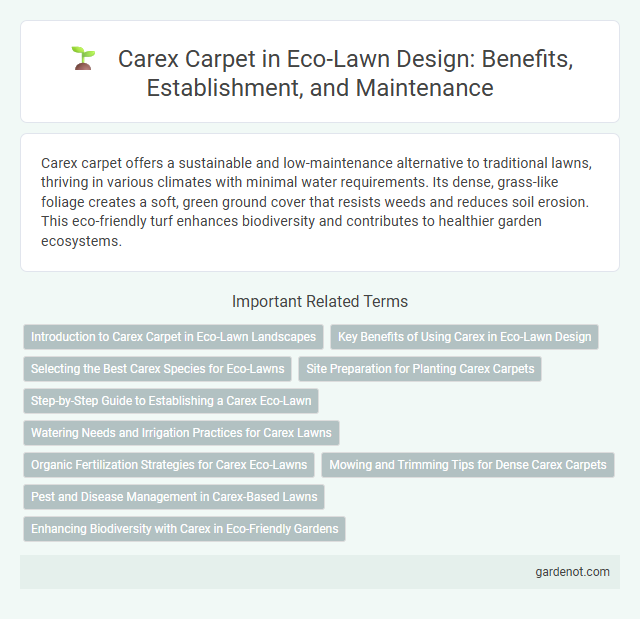Carex carpet offers a sustainable and low-maintenance alternative to traditional lawns, thriving in various climates with minimal water requirements. Its dense, grass-like foliage creates a soft, green ground cover that resists weeds and reduces soil erosion. This eco-friendly turf enhances biodiversity and contributes to healthier garden ecosystems.
Introduction to Carex Carpet in Eco-Lawn Landscapes
Carex Carpet is a versatile, low-maintenance sedge ideal for eco-lawn landscapes due to its drought tolerance and shade adaptability. Its dense, fine-textured foliage provides excellent ground cover, reducing soil erosion and minimizing water usage. Incorporating Carex Carpet enhances biodiversity by supporting native pollinators and requiring fewer chemical inputs compared to traditional grass lawns.
Key Benefits of Using Carex in Eco-Lawn Design
Carex carpet enhances eco-lawn design by offering drought tolerance and low maintenance, reducing water usage and upkeep costs. Its dense root system improves soil stability and prevents erosion, promoting a sustainable landscape. The plant also supports biodiversity by providing habitat for beneficial insects and wildlife, contributing to a balanced ecosystem.
Selecting the Best Carex Species for Eco-Lawns
Selecting the best Carex species for eco-lawns involves prioritizing drought-tolerant, low-maintenance varieties such as Carex pensylvanica, Carex scoparia, and Carex flacca. These species excel in providing erosion control, supporting biodiversity, and thriving in various soil types while reducing water consumption. Opting for native Carex species enhances the eco-lawn's resilience and environmental benefits.
Site Preparation for Planting Carex Carpets
Site preparation for planting Carex carpets involves thorough soil assessment and amendment to ensure optimal drainage and nutrient availability, favoring slightly acidic to neutral pH levels. Removing existing vegetation, loosening the soil to a depth of 15-20 cm, and incorporating organic matter enhances root establishment and moisture retention. Proper site grading minimizes waterlogging risks, promoting healthy Carex growth in eco-lawn applications.
Step-by-Step Guide to Establishing a Carex Eco-Lawn
Prepare the soil by removing weeds and loosening the top 15 cm to improve drainage for Carex carpet establishment. Plant Carex plugs or seeds evenly, spacing plugs 20-30 cm apart to encourage dense, uniform growth. Maintain consistent moisture during the first 6-8 weeks and mow lightly once the grass reaches 10 cm to promote healthy turf development.
Watering Needs and Irrigation Practices for Carex Lawns
Carex carpet lawns require moderate watering to maintain their lush appearance, preferring well-drained soil with consistent moisture but avoiding waterlogging. Irrigation practices should emphasize deep, infrequent watering to encourage strong root development and drought resilience. Efficient drip irrigation or soaker hoses minimize water waste and promote healthy Carex growth, especially during dry periods.
Organic Fertilization Strategies for Carex Eco-Lawns
Organic fertilization strategies for Carex eco-lawns enhance soil health while promoting dense, resilient turf. Utilizing composted manure or organic mulch improves nutrient availability and supports beneficial microbial activity essential for Carex growth. Slow-release organic fertilizers maintain balanced nitrogen levels, reducing runoff and promoting sustainable, eco-friendly lawn care.
Mowing and Trimming Tips for Dense Carex Carpets
Mowing Carex carpets requires maintaining a height of 2 to 3 inches to promote dense growth while avoiding scalp damage. Regular trimming with sharp blades or shears helps keep the dense foliage tidy and encourages healthier, more resilient turf. Timing mowing during dry conditions reduces soil compaction and preserves the delicate root structure of the Carex.
Pest and Disease Management in Carex-Based Lawns
Carex carpet, a sustainable choice for eco-lawns, exhibits high resistance to common pests like aphids and spider mites, reducing the need for chemical pesticides. Integrated pest management (IPM) practices, including regular monitoring and promoting natural predators such as ladybugs, further protect Carex lawns from infestations. Disease occurrences are rare due to Carex's dense growth habit, which limits fungal infections, but maintaining proper drainage prevents root rot and other moisture-related issues.
Enhancing Biodiversity with Carex in Eco-Friendly Gardens
Carex carpet, a low-growing sedge, significantly enhances biodiversity in eco-friendly gardens by providing habitat and food sources for native insects and pollinators. Its dense, mat-forming growth improves soil health through natural erosion control and moisture retention, supporting resilient garden ecosystems. Incorporating Carex species promotes sustainable landscaping by reducing the need for chemical fertilizers and irrigation, aligning with eco-lawn principles.
Carex carpet Infographic

 gardenot.com
gardenot.com